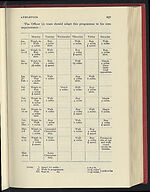1957-58
(250)
Download files
Complete book:
Individual page:
Thumbnail gallery: Grid view | List view

236
ATHLETICS
6.
(Standing). Knee raise and hug to chest alternately with arms
raising upward.
7. High skip jumps, knees to chest (with rebound).
8. (Two make backs as for leap frog, the third with hands on
shoulders). Hitch kick action whilst supported. Later, at slow run.
9. Forward jump with arms swinging forward.
io. Run three paces forward, take off with "heel, tread, toe,"
action with high knee and arm lift (land on take-off foot).
I
x. Series of hops concentrating on forward and backward swing
of non jumping leg.
12.
(High across sitting with knees raised forward and arms
forward upward). Standing up by stretching knees and swinging
arms downward—backward and forward.
9.
Running
i. (Heels raised, balls of foot) lifting on to tip-toes, later on to
alternate tip-toes.
2.
(Arms running position). Easy arm motion, later with running
on spot.
3.
(Heels raised, arms running position). Lean forward, run
easily, keeping strides on each side of a straight line.
4. (Pairs, heels raised with support). Alternate knee pressing
forward with lifting on to tip-toes. Later at running speed.
5. (Sprint start position). Slow start.
B. Hints on Training a Cross
-
Country Team
(These are notes written for those who have only a limited time for
training.)
(a)
Objective.
It is essential constantly to have in mind the
event for which the team is being trained, so that the training may
reach a climax on the day of the competition.
(b) Selection
of
Team.
Bearing in mind the conditions of the race,
size of team required, facilities for training, etc., the team should be,
selected after holding preliminary trials.
(c)
Clothing and Footgear.
It will not be necessary to equip the
team
with elaborate kit, but attention must be paid to the personal
kit of the men. This especially applies to his vest, shorts, socks and
shoes. Lack of proper attention to these details leads to minor
injuries, rubs, blisters, sores and ailments such as colds when train-
ing during the winter months.
(d) Training.
The following points concerning training should
be carefully observed :
(i) A programme for the time available should be mapped '
out and training should not be hastened unduly (see speci-
men programme on page
237.
(ii) Keep to the programme and insist on the men turning
out for training in all sorts of weather.
(iii) From the very beginning, instil into the team a sense of
time and space.
ATHLETICS
6.
(Standing). Knee raise and hug to chest alternately with arms
raising upward.
7. High skip jumps, knees to chest (with rebound).
8. (Two make backs as for leap frog, the third with hands on
shoulders). Hitch kick action whilst supported. Later, at slow run.
9. Forward jump with arms swinging forward.
io. Run three paces forward, take off with "heel, tread, toe,"
action with high knee and arm lift (land on take-off foot).
I
x. Series of hops concentrating on forward and backward swing
of non jumping leg.
12.
(High across sitting with knees raised forward and arms
forward upward). Standing up by stretching knees and swinging
arms downward—backward and forward.
9.
Running
i. (Heels raised, balls of foot) lifting on to tip-toes, later on to
alternate tip-toes.
2.
(Arms running position). Easy arm motion, later with running
on spot.
3.
(Heels raised, arms running position). Lean forward, run
easily, keeping strides on each side of a straight line.
4. (Pairs, heels raised with support). Alternate knee pressing
forward with lifting on to tip-toes. Later at running speed.
5. (Sprint start position). Slow start.
B. Hints on Training a Cross
-
Country Team
(These are notes written for those who have only a limited time for
training.)
(a)
Objective.
It is essential constantly to have in mind the
event for which the team is being trained, so that the training may
reach a climax on the day of the competition.
(b) Selection
of
Team.
Bearing in mind the conditions of the race,
size of team required, facilities for training, etc., the team should be,
selected after holding preliminary trials.
(c)
Clothing and Footgear.
It will not be necessary to equip the
team
with elaborate kit, but attention must be paid to the personal
kit of the men. This especially applies to his vest, shorts, socks and
shoes. Lack of proper attention to these details leads to minor
injuries, rubs, blisters, sores and ailments such as colds when train-
ing during the winter months.
(d) Training.
The following points concerning training should
be carefully observed :
(i) A programme for the time available should be mapped '
out and training should not be hastened unduly (see speci-
men programme on page
237.
(ii) Keep to the programme and insist on the men turning
out for training in all sorts of weather.
(iii) From the very beginning, instil into the team a sense of
time and space.
Set display mode to:
![]() Universal Viewer |
Universal Viewer | ![]() Mirador |
Large image | Transcription
Mirador |
Large image | Transcription
| Games and sports in the army > 1957-58 > (250) |
|---|
| Permanent URL | https://digital.nls.uk/248854247 |
|---|
| Description | 'Games and Sports in the Army' was an annual publication produced by the British War Office between the 1930s and 1960s. This included the Second World War. It outlines the rules and regulations for games and sports played by members of the armed forces. It features names and photographs of team members, and examples of contemporary advertising. |
|---|---|
| Shelfmark | GWB.52 |

